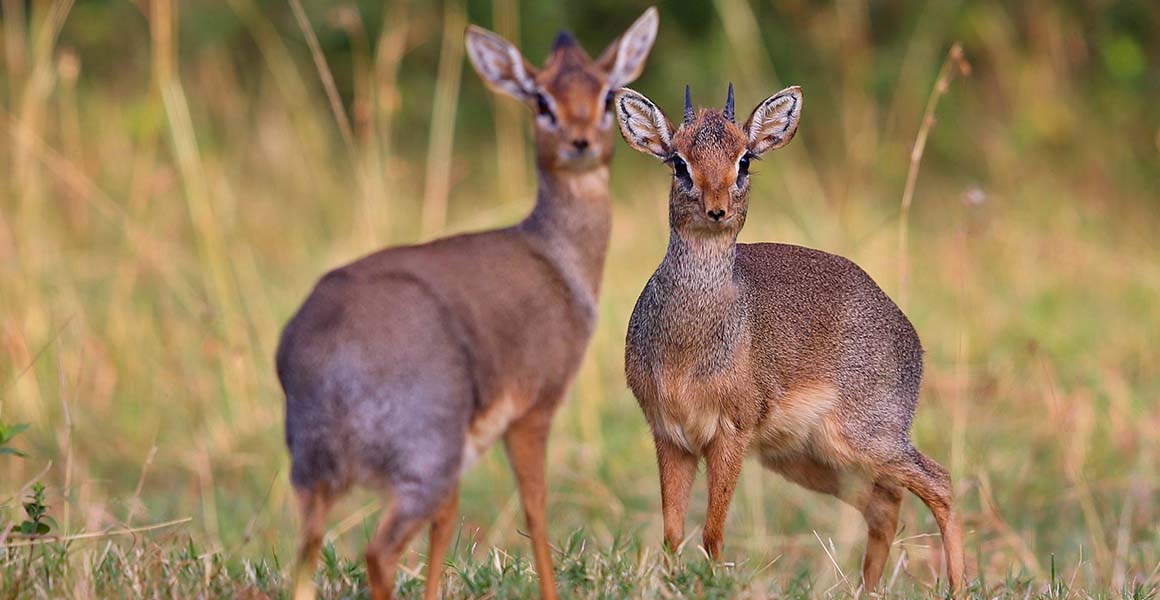It’s often assumed that male mammals are bigger than their female counterparts, but this might not actually be the case.
After comparing hundreds of mammal species, scientists have found that when it comes to sexual selection, size isn’t everything.

While female dik diks are larger than their male counterparts, research tends to focus on the males instead. © PhotocechCZ/ Shutterstock.
It’s often assumed that male mammals are bigger than their female counterparts, but this might not actually be the case.
After comparing hundreds of mammal species, scientists have found that when it comes to sexual selection, size isn’t everything.
New research is cutting male mammals down to size.
While we may think of hulking elephant seal bulls or huge stags, these males appear to be the exception, rather than the rule. A new analysis of over 400 species suggests that there are more mammals where the females are actually the same size as, or larger than the males.
Dr Kaia Tombak, the lead author of the research, suggests this misconception might be fuelled by a focus on mammals where larger males are more common, like primates, as well as a broader lack of research into female animals.
“It’s possible that that societal biases in general have influenced the inertia in shifting from the ‘larger males’ narrative,” Kaia says. “This is both as a research bias and as a broader societal bias, since it aligns with the power hierarchies in our Western societies.”
The research highlights the growing awareness of sex biases in biology, but the team note that their paper is not the final word on biological sex and size. Having only been able to include 7% of mammals in their study, future research with more species might reveal that males are larger after all.
The findings of the study were published in the journal Nature.

In the Beisa oryx, as in 39% of mammals in the study, males and females are a similar size. © Kaia Tombak.
At its most basic level, natural selection is all about passing genes onto the next generation. Any characteristic that allows an animal to have more offspring, be it higher fertility or a longer life, is likely to spread throughout a species as it evolves.
Size is one of these characteristics. A bigger animal might have a stronger bite or be able to reach new sources of food, giving it an important survival advantage over others of its species.
Survival is certainly important, but an animal still needs to pass on its genes to the next generation. This is where sexual selection comes in, reflecting competition among males and females, and each other, to reproduce.
Sexual selection is generally thought to be more important for males than females, especially in mammals. Large male deer, for example, are better able to defeat smaller rivals in fights over females, making it more likely they will reproduce more.
This picture is borne out in other mammals. The size of male elephant seals and gorillas, for instance, is likewise linked to their dominance and reproductive success.
Studies of sexual size differences have tended to focus on large, charismatic animals like these. Meanwhile, rodents and bats, which make up more than half of all mammal species, have been the subject of much less research.
“I think the taxonomic bias in sexual selection research towards charismatic fauna definitely played a role in past research,” Kaia explains. “Most of the data that previous studies used came from primates, carnivores, and ungulates, which have high rates of male-biased dimorphism.”
“But as most mammals are rodents and bats, you need to weigh the data accordingly if you want to talk about mammals more widely.”
What research does exist reveals that the males and females of many small mammals are similarly sized. In fact, in some cases the females are bigger. But the broader narrative of males being the larger of the sexes has remained.
To see whether this belief is justified, the researchers scoured existing datasets for mammal size data. Their findings suggest that it’s not as clear cut as believed.

Male elephant seals can be up to 3.2 times larger than females, which is one of the most extreme differences between the sexes across all mammals. © Alex Chernyavsky/ Shutterstock.
After comparing 429 mammal species, the researchers found bigger males in 45% of the species in their sample. But these males are not in the majority, as 16% of the animals had larger females, and there’s no significant difference between the sexes in the rest.
The exact picture varies by group, with some species showing greater size differences than others. Almost half of bats, for example, have larger females than males, rising to 60% of rabbits and hares.
Meanwhile, horses, lemurs, golden moles and tenrecs often had equally sized sexes. This was also true in almost half of rodents, the most species-rich group of mammals.
Larger males do dominate in some groups, however. In the carnivorans, which includes bears, cats and seals, the researchers found no evidence of females being bigger than males. Elephant seals show the most dramatic difference between the sexes – the males are on average three times heavier than their female counterparts.
This reflects a broader pattern in mammals, where species with bigger males tend to have more extreme size differences between the sexes. In these species, males are on average 1.3 times bigger than females, while mammals with a female size bias are around 1.1 times larger.
“Extreme size differences in species with larger males have traditionally been attributed to high male-male competition for mates,” Kaia says. “However, clearly there is more to the story and there is other evidence to show that high mate competition isn’t necessarily always the case in mammals.”
“At the moment, we just don’t know why these species have more extreme differences.”
The group’s findings highlight the lack of scientific attention paid to female animals and less charismatic species, as well as raising interesting questions about sexual selection. For example, does being the same size as the opposite sex offer any advantages? Is bigger necessarily better and if males aren’t larger than females, do they compete in other ways aside from fights?
To answer these questions, research on many more species will be crucial to confirm this study’s results one way or the other, and to show how big a deal size is in the battle of the sexes.

We're working towards a future where both people and the planet thrive.
Hear from scientists studying human impact and change in the natural world.
Don't miss a thing
Receive email updates about our news, science, exhibitions, events, products, services and fundraising activities. We may occasionally include third-party content from our corporate partners and other museums. We will not share your personal details with these third parties. You must be over the age of 13. Privacy notice.
Follow us on social media